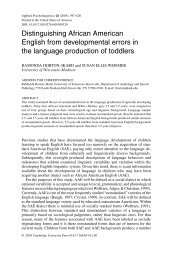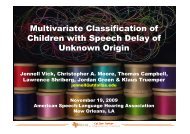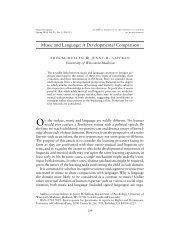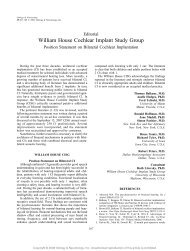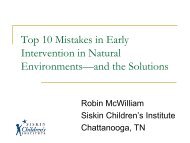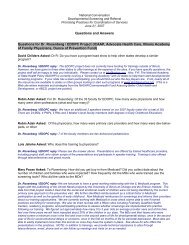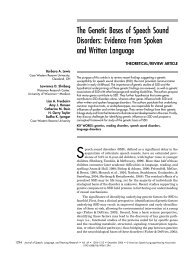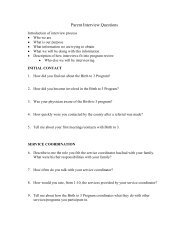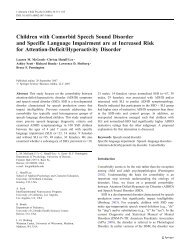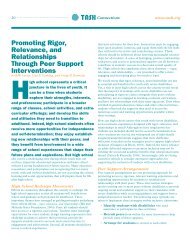Dr. Goldsmith's Full CV - Waisman Center - University of Wisconsin ...
Dr. Goldsmith's Full CV - Waisman Center - University of Wisconsin ...
Dr. Goldsmith's Full CV - Waisman Center - University of Wisconsin ...
You also want an ePaper? Increase the reach of your titles
YUMPU automatically turns print PDFs into web optimized ePapers that Google loves.
Nigg, J. T., Goldsmith, H. H., & Sachek, J. (2004). Temperament and Attention-<br />
Deficit/Hyperactivity Disorder: The development <strong>of</strong> a multiple pathway model. Journal <strong>of</strong><br />
Clinical Child and Adolescent Psychology, 33, 42-53.<br />
Goldsmith, H. H., Lemery, K. S., & Essex, M. J. (2004). Temperament as a liability factor for<br />
childhood behavioral disorders: The concept <strong>of</strong> liability. In L. F. DiLalla (Ed.). Behavior<br />
genetics principles: Perspectives in development, personality, and psychopathology (pp. 19-<br />
39). Washington, DC: American Psychological Association.<br />
Van Hulle, C. A., Goldsmith, H. H., & Lemery, K. S. (2004). Genetic, environmental, and<br />
gender effects on individual differences in toddler expressive language. Journal <strong>of</strong> Speech,<br />
Language, and Hearing Research, 47, 904-912.<br />
Hyde, J. S., Else-Quest, N. M., Goldsmith, H. H., & Biesanz, J. C. (2004). Children’s<br />
temperament and behavior problems predict their employed mothers’ work functioning.<br />
Child Development, 75, 580-594.<br />
Goldsmith, H. H., Gernsbacher, M. A., Crabbe, J., Dawson, G., Gottesman, I. I., Hewitt, J.,<br />
McGue, M., Pedersen, N., Plomin, R., Rose, R. J., & Swanson, J. (2003). Comment:<br />
Research psychologists’ roles in the genetic revolution. American Psychologist, 58, 318-319.<br />
Buss, K. A., Schumacher, J. R., Dolski, I., Kalin, N. H., Goldsmith, H. H., & Davidson, R. J.<br />
(2003). Right frontal brain activity, cortisol, and withdrawal behavior in 6-month-old infants.<br />
Behavioral Neuroscience, 117, 11-20.<br />
Goldsmith, H. H. (2003). Gene-to-behavior pathways. In D. N. Cooper (Ed.) Nature<br />
Encyclopedia <strong>of</strong> the Human Genome, vol. 2, pp. 968-971. London: Nature Publishing Group.<br />
Essex, M. J., Goldsmith, H. H., Smider, N. A., Dolski, I., Sutton, S. K., & Davidson, R. J.,<br />
(2003). Comparison <strong>of</strong> video- and EMG-based evaluations <strong>of</strong> the amplitude <strong>of</strong> children’s<br />
emotion-modulated startle response. Behavior Research Methods, Instruments, and<br />
Computers, 35, 590-598.<br />
Nigg, J., & Goldsmith, H. H. (2003). Personality and temperament. In D. N. Cooper (Ed.) Nature<br />
Encyclopedia <strong>of</strong> the Human Genome, vol. 4, pp. 549-556. London: Nature Publishing Group.<br />
Aksan, N., & Goldsmith, H. H. (2003). Temperament and guilt representations in children’s<br />
narratives. In R. N. Emde, D. P. Wolf, & D. Oppenheim (Eds.), Revealing the Inner Worlds<br />
<strong>of</strong> Young Children: The MacArthur Story Stem Battery and Parent-Child Narratives (pp.<br />
129-146). New York: Oxford <strong>University</strong> Press.<br />
Goldsmith, H. H., & Hewitt, E. (2003). Validity <strong>of</strong> parental report <strong>of</strong> temperament: Distinctions<br />
and needed research. Infant Behavior and Development, 26, 108-111.<br />
Page 17



